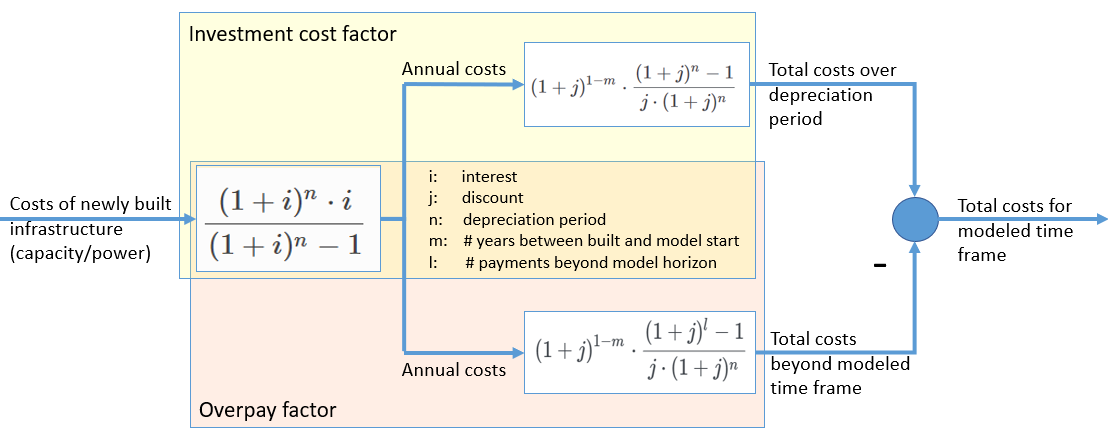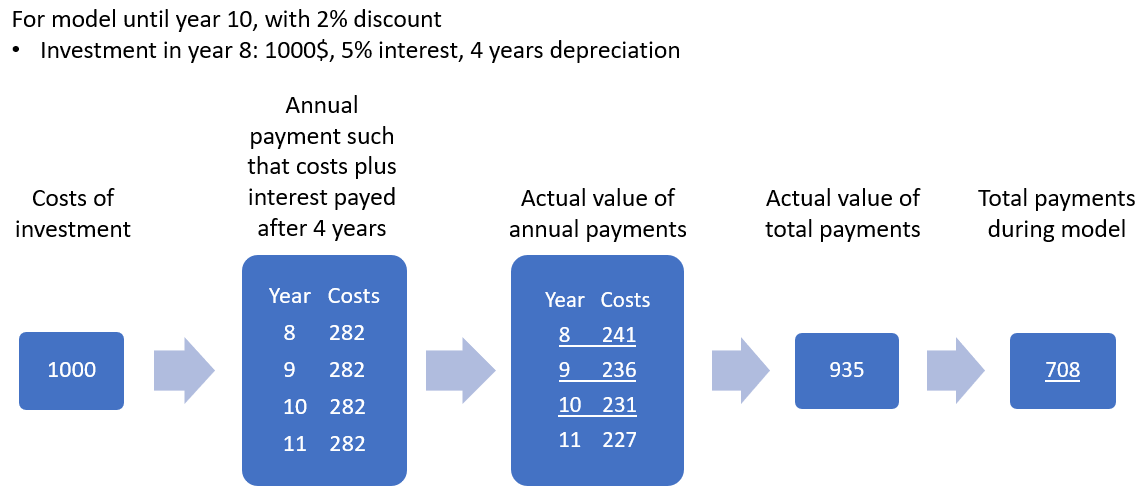urbs¶
On this page, the most important equations like the objective function and constraints are stated.
Objective function¶
The objective function consists of five parts:
Investment costs
- consists of investment costs for generation, transmission and storage
- investment costs for trans and sto are calculated the same way as for gen, except sto costs are based on newly installed storage capacity and power
Graphical representation and example of the calculation of total costs for an investment
Fixed costs for operation and maintenance
- consists of fixed costs for generation, transmission and storage
- fixed costs for trans and sto are calculated the same way as for gen, except again sto costs are based on installed storage capacity and power
Variable operation and maintenance costs
- consists of fixed costs for generation, transmission and storage
- fixed costs for trans and sto are calculated the same way as for gen, except trans costs are only based on transmission input and sto costs are based on energy content, inflow and outflow
Fuel costs
Environment costs like costs for CO_2 emissions
Marked in red: things that are not in the terminology. All of these are explained in the following table:
| Name | Domains | Type | Description |
|---|---|---|---|
| P | Set | Tuple including all sets describing processes (year, site, process) | |
| F, E | Set | Tuples inluding all sets describing commodities (year, site, com, com type), where e is the subset of stock and f the subset of environmental commodities | |
| INVESTFAC | p | Parameter | Scales the investment costs taking into account the depreciation duration, interest rate and discount rate |
| OVRPAYFAC | p | Parameter | Similar to INVESTFAC but calculates the investment cost payments that fall beyond the optimization period, thus should not be considered |
| NEWCAPACITY | p | Variable | Amount of new capacity of a technology |
| COSTFAC | p, e or f | Parameter | Includes discount factor and relative weight of a year for intertemporal model, for single year equals one |
| Weight | Parameter | Scales the costs to a full year | |
| CB(e,t) | Function | Balance equation returning the amount of environmental commodity created |
Constraints¶
Process expansion constraints¶
The unit expansion constraints are independent of the modeled time. In case of the minimal model the are restricted to two constraints only limiting the allowed capacity expansion for each process. The total capacity of a given process is simply given by:
where \(K_{y,g}\) is the already installed capacity of process (generator) \(g\) in year y.
Process capacity limit rule¶
The capacity pf each process \(g\) is limited by a maximal and minimal capacity, \(\overline{K}_g\) and \(\underline{K}_g\), respectively, which are both given to the model as parameters:
All further constraints are time dependent and are determinants of the unit commitment, i.e. the time series of operation of all processes and commodity flows.
Commodity dispatch constraints¶
In this part the rules governing the commodity flow timeseries are shown.
Vertex rule (“Kirchhoffs current law”)¶
This rule is the central rule for the commodity flows and states that all commodity flows, (except for those of environmental commodities) have to be balanced in each time step. As a helper function the already mentioned commodity balance is calculated in the following way:
Here, the tuple sets \(D^{\mathrm{in,out}}_g\) represent all input and output commodities of process \(g\), respectively. The commodity balance thus simply calculates how much more of commodity \(d\) is emitted by than added to the system via process \(g\) in timestep \(t\). Using this term the vertex rule for the various commodity types can now be written in the following way:
where \(D_{\text{st}}\) is the set of stock commodities and:
where \(D_{\text{dem}}\) is the set of demand commodities and \(E_{y,d,t}\) the corresponding demand for commodity \(d\) at time \(t\) at year \(y\). These two rules thus state that all stock commodities that are consumed at any time in any process must be taken from the stock and that all demands have to be fulfilled at each time step.
Stock commodity limitations¶
There are two rule that govern the retrieval of stock commodities from stock: The total stock and the stock per hour rule. The former limits the total amount of stock commodity that can be retrieved annually and the latter limits the same quantity per timestep. the two rules take the following form:
where \(\Lambda_{y,d}\) and \(\lambda_{y,d}\) are the totally allowed annual and hourly retrieval of commodity \(d\) from the stock, respectively, in year \(y\).
Environmental commodity limitations¶
Similar to stock commodities, environmental commodities can also be limited per hour or per year. Both properties are assured by the following two rules:
where \(\Lambda^\text{env}_{y,d}\) and \(\lambda^\text{env}_{y,d}\) are the totally allowed annual and hourly emissions of environmental commodity \(d\) to the atmosphere, respectively, in year \(y\).
Process dispatch constraints¶
So far, apart from the commodity balance function, the interaction between processes and commodities have not been discussed. It is perhaps in order to start with the general idea behind the modeling of the process operation. In urbs all processes are mimo-processes, i.e., in general they in take in multiple commodities as inputs and give out multiple commodities as outputs. The respective ratios between the respective commodity flows remain normally fixed. The operational state of the process is then captured in just one variable, the process throughput \(\tau_{gt}\) and is is linked to the commodity flows via the following two rules:
where \(r^{\text{in, out}}_{y,g,d}\) are the constant factors linking the commodity flow to the operational state. The efficiency \(\eta\) of the process \(g\) for the conversion of commodity \(d_1\) into commodity \(d_2\) is then simply given by:
Basic process throughput rules¶
The throughput \(\tau_{gt}\) of a process is limited by its installed capacity and the specified minimal operational state. Furthermore, the switching speed of a process can be limited:
where \(\underline{P}_{y,g}\) is the normalized, minimal operational state of the process and \(\overline{PG}_{y,g}\) the normalized, maximal gradient of the operational state in full capacity per timestep.
Intermittent supply rule¶
If the input commodity is of type ‘SupIm’, which means that it represents an operational state rather than a proper material flow, the operational state of the process is governed by this alone. This feature is typically used for renewable energies but can be used whenever a certain operation time series of a given process is desired
Here, \(\gamma^{capa}_{y,g,t}\) is the time series that governs the exact operation of process \(g\), leaving only its capacity \(\kappa_{y,g}\) as a free variable.
Part load behavior¶
Many processes show a non-trivial part-load behavior. In particular, often a nonlinear reaction of the efficiency on the operational state is given. Although urbs itself is a linear program this can with some caveats be captured in many cases. The reason for this is, that the efficiency of a process is itself not modeled but only the ratio between input and output multipliers. It is thus possible to use purely linear functions to get a nonlinear behavior of the efficiency of the form:
where a,b,c and d are some constants. Specifically, the input and output ratios can be set to vary linearly between their respective values at full load \(r^{\text{in,out}}_{y,g,d}\) and their values at the minimal allowed operational state \(\underline{P}_{y,g}\kappa_{y,g}\), which are given by \(\underline{r}^{\text{in,out}}_{y,g,d}\). This is achieved with the following equations:
A few restrictions have to be kept in mind when using this feature:
- \(\underline{P}_{y,g}\) has to be set larger than 0 otherwise the feature will work but not have any effect.
- Environmental output commodities have to mimic the behavior of the inputs by which they are generated. Otherwise the emissions per unit of input would change together with the efficiency, which is typically not the desired behavior.

